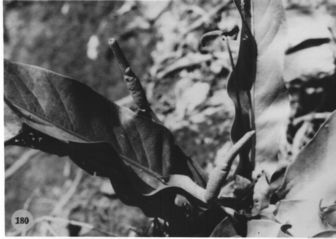




Anthurium schlechtendalii ssp. jimenezii (Matuda) Croat, comb. nov.
LEAVES erect-spreading; petioles 2-15 cm long, 8-9 mm diam., subquadrangular, broadly and sharply sulcate; geniculum 1-1.5 cm long; blades oblanceolate to lanceolate, gradually acuminate at apex (the acumen apiculate), obtuse to narrowly rounded at base, broadest at middle, 36-104 cm long, 6-32 cm wide; both surfaces semiglossy, lower surface sometimes having a bluish-green color; midrib slightly raised at base, more acutely raised midway and sunken at apex above, quadrangular and prominently raised below, becoming convex at apex; primary lateral veins 9-14 per side, departing midrib at 50° angle, raised above, usually raised below, arcuate-ascending; interprimary veins weakly sunken above, prominulous below; lesser veins obscure above, visible below; collective vein arising from one of the primary lateral veins in the lower half of blade, 2-4 mm from margin, flat above, prominulous below.
INFLORESCENCE erect, shorter than leaves; peduncle 10-54 cm long, 3-5 mm diam., terete, longer than petioles; spathe subcoriaceous, green weakly tinged with purple (B & K Yellow-green 6/5), 4-8.5 cm long, 1-2.5 cm wide, lanceolate, oblique and narrowly acuminate at apex, subcordate at base, broadest just above base, inserted at 30° angle on peduncle; spadix usually sessile, greenish tinged with purple (B & K Yellow-green 6/5), 3.5-14 cm long, 5-10 mm diam. at base, 2-5 mm diam. at apex; the flowers rhombic to sub-4-lobed, 2.7-2.8 mm long, 2.3-2.5 mm wide, the sides straight lojag-gedly sigmoid; 11-12 flowers visible in the principal spiral, 7-8 flowers visible in the alternate spiral; the tepals matte, obscurely and sparsely punctate with numerous, irregular droplets at an-thesis, lateral tepals 1.5 mm wide, the inner margin broadly rounded, the outer margin 3-4 sided; pistils weakly emergent, medium green; the stigma 0.5 mm long, oblong-elliptic; stamens emerging in a prompt complete sequence from the base; the anthers creamy white, leaning over edge of pisiol, 0.8 mm long, 1 mm wide; thecae oblong-elliptic, slightly divaricate; pollen white.
INFRUCTESCENCE pendent; berries red, oblong-cllipsoid, rounded at apex, 11 mm long, 9 mm wide; mesocarp with raphide cells dense and numerous throughout; seeds 2, oblong-ellipsoid, tan, flattened, 6 mm long, 4 mm wide, 2 mm thick with pale, punctiform raphide cells, encased in a slender, sticky, gelatinous, apically elongated envelope. Fig. 180.
Anthurium schlechtendalii ssp. jimenezil is endemic to Mexico and is restricted to Guerrero and southern Oaxaca in seasonally very dry forests at 250 to 1,350 m elevation. Subspecies jimenezii is recognized by its exclusively terrestrial or rupicolous habit, its thick, oblanceolate leaf blades with usually free-ending primary lateral veins, its purplish spadix, green, lanceolate spathe, and red berries. This subspecies is geographically isolated from the typical subspecies of A. schlechtendalii, which is found in northern Oaxaca and also on the eastern side of the Isthmus of Tehuantepec but not in eastern Oaxaca. Subspecies jimenezii differs from the typical subspecies in being generally smaller, by occurring exclusively on rocks and in seasonally much drier habitats, and by having usually thicker leaf blades. Matuda (1961) stressed that the taxon has peduncles relatively much longer than typical in A. schlechtendalii. While it is generally true that the inflorescences of ssp. jimenezii are commonly as long as or longer than the leaves they may also be much shorter than the leaves.
Subspecies jimenezii is also similar to A. halmoorei, which differs in having an ovate to ovate-elliptic spathe and mature berries that are pale greenish-yellow. Also similar is A. nizandense, which is endemic to southern Guerrero and southern Oaxaca. Anthurium nizandense differs in having proportionately much longer petioles and elliptic to oblong-elliptic blades that are matte on the lower surface. In A. nizandense the blades are 1.3-2.5 times longer than the petioles whereas in A. schlechtendalii ssp. jimenezii the leaf blades are usually 6 to 10 times longer (rarely only as little as 3 times longer).
 |
Map of Mesoamerican specimens with coordinates
Mexico Chiapas: Mpo. Angel Albino Corzo, 1380 m,, 7 Apr. 1981, Breedlove
50763 (MO).
Mexico Chiapas: Mpo. Cintalapa de Figueroa, 560 m,, 29 March 1981,
Breedlove 50560 (MO).
Mexico Chiapas:, 21 Sept. 1983, Tellez & Pankhurst 7058 (MO).
Mexico Chiapas: 4800 ft,, 20 Jun 1982, Utley & Utley 6813 (MO).
Mexico Guerrero: 2325 m,, 14 Jan. 1979, Thomas B. Croat 45621B (MO).
Mexico Guerrero: 1500 m,, 15 Jan. 1979, Thomas B. Croat 45694 (K, M,
MO).
Mexico Guerrero: 1300-1500 m, 17.24N 100.17W, 1 Feb. 1983, Miller &
Tenorio 639 (MO)
Mexico Guerrero:, , Crisman & Willis 199 (MICH).
Mexico Guerrero:, , Hinton et al. 10098 (US).
Mexico Guerrero:, , Matuda 37245 (MEXU).
Mexico Guerrero:, , Moore 5099 (BH).
Mexico Guerrero:, , Moore 5120 (BH, UC).
Mexico Guerrero:, , Moore 6957 (BH).
Mexico Guerrero:, , Rodriguez 51 (US).
Mexico Guerrero:, , Rzedowski 22809 (MICH, US).
Mexico Guerrero: Dtto. Mina,, , Hinton 10125 (GH, K, US).
Mexico Jalisco: 975 m, 20.21.21N 105.17.09W, 4 Jan. 1990, Cochrane
et al. 11909 (MO, WIS).
Mexico Oaxaca: 1480 m,, 17 Jan. 1979, Thomas B. Croat 45926 (MO).
Mexico Oaxaca: 1540 m,, 20 Jan. 1979, Thomas B. Croat 46093 (MO).
Mexico Oaxaca: 1340 m,, 20 Jan. 1979, Thomas B. Croat 46142 (K, MO,
(cult. at Kew)).
Mexico Oaxaca:, , Rzedowski 19592 (MEXU).
Mexico Oaxaca: Mpo. Matías Romero, 200-300 m, 16.58N 95.04W,
24 Apr 1985, Wendt et. al 4816 (MO).
Mexico Oaxaca: 1390 m, 16.11N 97.00W, 21 Feb. 1988, Campos , A. &
J. Reyes 1322 (MEXU, MO).
Mexico Oaxaca: 16.40N 94.54W, 3 Feb 1988, Cipriano Martínez R. 1271
(MEXU, MO).